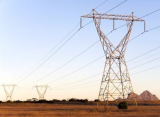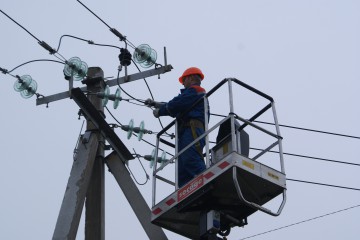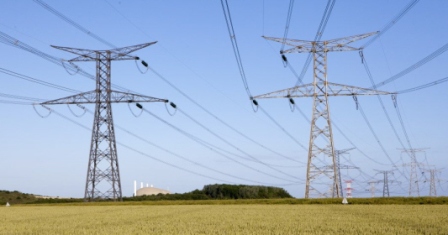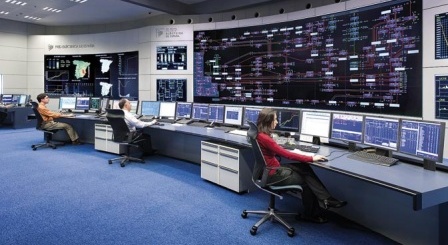Balance ownership of power grids
 The electrical grids entangled everything around like a spider's web. This applies especially to populated areas, areas near distribution substations, industrial enterprises. Therefore, if it is necessary to carry out construction, excavation or other work near power lines, it is necessary to agree with the organization on the balance on which this or that power line is located.
The electrical grids entangled everything around like a spider's web. This applies especially to populated areas, areas near distribution substations, industrial enterprises. Therefore, if it is necessary to carry out construction, excavation or other work near power lines, it is necessary to agree with the organization on the balance on which this or that power line is located.
How to determine which company the power line belongs to? Electrical networks, both cable and aerial, depending on the voltage, location and purpose, have different accessories. Below we will consider the general principle of dividing electrical networks depending on their voltage class.
Networks with a voltage class of 0.4 kV
Electric networks with a voltage class of 0.4 kV include domestic and industrial networks with a voltage of 220/380 V. Electric networks located on the territory of populated areas, as a rule, have a balance belonging to RES — to regional electric networks.
In large cities, each district of the city belongs to a separate department of RES.The electrical networks of small towns, villages, as a rule, are united in one RES, usually within the same administrative region, including the regional center. Most RES users are household users, various government agencies. Also, this organization can provide power supply through 0.4 kV networks to small enterprises, sites of legal entities.
Industrial networks of 0.4 kV, as a rule, pass through the territory of enterprises that have their own step-down substations. These networks are owned by the given enterprise, they are operated by the relevant office of the enterprise.

Networks with a voltage of 6, 10 kV
The next voltage class of power transmission networks is 6-10 kV. Networks with a voltage of 6 and 10 kV do not differ in appearance. The voltage of 10 kV is chosen if the electrical networks exclusively supply domestic consumers and enterprises whose equipment is powered by networks with a voltage of up to 1000 V.
The voltage of 6 kV in electrical networks is used if an industrial plant is installed high voltage equipmentpowered directly from this voltage. The 6 kV voltage is also used to supply the step-down substations of domestic consumers. This voltage is mainly used in areas where several enterprises are concentrated, where there is high voltage equipment.
The 6-10 kV electrical networks, feeding substations of domestic consumers, are served by the relevant RES enterprises. Lines supplying enterprises may be owned by those enterprises or by a separate specialized organization.
For example, if there are many factories and mines in a region, the supply of these enterprises can be carried out by an organization that specializes exclusively in industrial users.

Networks with a voltage of 35, 110 kV
RES operates electrical networks with a voltage of 0.4-10 kV. The following link in power system are high-voltage lines of voltage class 35 and 110 kV... These lines feed the power supply substations of RES, where the voltage is converted to 6 or 10 kV. Also, these electrical networks can supply step-down substations of large industrial plants.
The higher the voltage, the smaller the number of power lines located in a certain region, therefore, the operation of electrical networks 35-110 kV is carried out by organizations that combine several RES.
35 kV lines, as well as 0.4-10 kV lines, are owned by one organization. Due to their long length, 110 kV lines can be in the balance of several enterprises. For example, 30 km of the line is in the balance of one organization, and 50 km passing through the territory of another region is in the balance of the organization that supplies electricity to this region.
Several suppliers may be located in the territory of the same region. The networks are divided for the convenience of their service and work with users.
For example, one enterprise manages electric networks supplying consumers to distribution areas, another enterprise supplies industrial facilities on the territory of a given region. Therefore, often two substations or power lines located in close proximity may belong to different enterprises.
Electric networks with a voltage of 110 kV can be transit (main), that is, provide communication between several regions. Accordingly, these electric grids will be in the balance of the larger enterprises working with electric grids in the region, a large part of the energy system.
They are often called enterprises operating in 35-110 kV high-voltage electrical networks — hydroelectric power plants.
Networks with a voltage of 220-750 kV
Electric networks of this voltage class are called trunk lines - MES... These networks are one of the most important arteries of the interconnected energy system of the country. These networks are in the balance of the enterprises of the Ministry of Education and Culture, which maintain networks in several regions of the country.

Operational management of electrical networks
On-balance sheet ownership of electric grids implies that the company operates and maintains electric grids. There is also such a thing as operational management of electrical networks. Electric networks together make up the power system of the district, region, country as a whole, therefore, in order to ensure stable and reliable operation of the power system, centralized management of power transmission networks is organized.
As a rule, in the electricity supply enterprises of RES, HPP, MES, etc. there are operational dispatch services that carry out the operational management of electrical networks. In this case, the power lines may be on the balance sheet of one enterprise, and their management will be carried out by another enterprise.
For example, a utility substation supplies power to the plant, and several lines from that substation supply power to step-down substations for residential consumers.In this case, the line will be in the balance of the first enterprise, but the operational management will be carried out by the second enterprise, which operates the networks of residential users.
We recommend you read: SCADA systems in electrical installations
